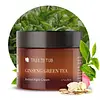What's inside
What's inside
 Key Ingredients
Key Ingredients

 Benefits
Benefits

 Concerns
Concerns

 Ingredients Side-by-side
Ingredients Side-by-side

Water
Skin ConditioningGlycerin
HumectantCarrageenan
Cocos Nucifera Fruit Extract
EmollientPinus Sylvestris Leaf Extract
TonicRetinol
Skin ConditioningHydrogenated Lecithin
EmulsifyingTocopheryl Acetate
AntioxidantOctapeptide-7
Skin ProtectingSh-Decapeptide-7
AntioxidantSh-Octapeptide-4
AntioxidantSh-Oligopeptide-9
HumectantSh-Pentapeptide-19
Skin ConditioningAloe Barbadensis Leaf Extract
EmollientRicinus Communis Seed Oil
MaskingAdenosine
Skin ConditioningAllantoin
Skin ConditioningCaffeine
Skin ConditioningPropanediol
SolventPolyglyceryl-10 Laurate
Skin ConditioningCeratonia Siliqua Gum
EmollientSucrose
HumectantCalcium Lactate
AstringentCalcium Chloride
AstringentCellulose Gum
Emulsion StabilisingPotassium Chloride
Cyamopsis Tetragonoloba Gum
Emulsion StabilisingArginine
MaskingHydrolyzed Extensin
Skin ConditioningDipotassium Glycyrrhizate
HumectantSynthetic Fluorphlogopite
Maltodextrin
AbsorbentSodium Hyaluronate
HumectantEthylhexylglycerin
Skin ConditioningTitanium Dioxide
Cosmetic ColorantChromium Oxide Greens
Polysorbate 20
EmulsifyingButylene Glycol
HumectantPentylene Glycol
Skin ConditioningEthyl Hexanediol
Solvent1,2-Hexanediol
Skin ConditioningChlorphenesin
AntimicrobialDisodium EDTA
Water, Glycerin, Carrageenan, Cocos Nucifera Fruit Extract, Pinus Sylvestris Leaf Extract, Retinol, Hydrogenated Lecithin, Tocopheryl Acetate, Octapeptide-7, Sh-Decapeptide-7, Sh-Octapeptide-4, Sh-Oligopeptide-9, Sh-Pentapeptide-19, Aloe Barbadensis Leaf Extract, Ricinus Communis Seed Oil, Adenosine, Allantoin, Caffeine, Propanediol, Polyglyceryl-10 Laurate, Ceratonia Siliqua Gum, Sucrose, Calcium Lactate, Calcium Chloride, Cellulose Gum, Potassium Chloride, Cyamopsis Tetragonoloba Gum, Arginine, Hydrolyzed Extensin, Dipotassium Glycyrrhizate, Synthetic Fluorphlogopite, Maltodextrin, Sodium Hyaluronate, Ethylhexylglycerin, Titanium Dioxide, Chromium Oxide Greens, Polysorbate 20, Butylene Glycol, Pentylene Glycol, Ethyl Hexanediol, 1,2-Hexanediol, Chlorphenesin, Disodium EDTA
Water
Skin ConditioningGlycerin
HumectantCaprylic/Capric Triglyceride
MaskingCoco-Caprylate/Caprate
EmollientCetearyl Olivate
Simmondsia Chinensis Seed Oil
EmollientSorbitan Olivate
Emulsifying1,2-Hexanediol
Skin ConditioningBetaine
HumectantPanthenol
Skin ConditioningRetinol
Skin ConditioningSodium Acrylates Copolymer
Lecithin
EmollientCopernicia Cerifera Wax
Propanediol
SolventDisodium Cocoamphodiacetate
CleansingHelianthus Annuus Seed Oil
EmollientCaprylyl Glycol
EmollientPanax Ginseng Root Extract
EmollientCamellia Sinensis Leaf Extract
AntimicrobialSodium Hyaluronate
HumectantTocopheryl Acetate
AntioxidantHydroxyacetophenone
AntioxidantRosa Damascena Flower Water
MaskingXanthan Gum
EmulsifyingPalmitoyl Hexapeptide-12
Skin ConditioningPalmitoyl Tetrapeptide-7
Skin ConditioningCaprylhydroxamic Acid
Cucumis Sativus Fruit Extract
EmollientPropylene Glycol
HumectantAloe Barbadensis Leaf Juice
Skin ConditioningWater, Glycerin, Caprylic/Capric Triglyceride, Coco-Caprylate/Caprate, Cetearyl Olivate, Simmondsia Chinensis Seed Oil, Sorbitan Olivate, 1,2-Hexanediol, Betaine, Panthenol, Retinol, Sodium Acrylates Copolymer, Lecithin, Copernicia Cerifera Wax, Propanediol, Disodium Cocoamphodiacetate, Helianthus Annuus Seed Oil, Caprylyl Glycol, Panax Ginseng Root Extract, Camellia Sinensis Leaf Extract, Sodium Hyaluronate, Tocopheryl Acetate, Hydroxyacetophenone, Rosa Damascena Flower Water, Xanthan Gum, Palmitoyl Hexapeptide-12, Palmitoyl Tetrapeptide-7, Caprylhydroxamic Acid, Cucumis Sativus Fruit Extract, Propylene Glycol, Aloe Barbadensis Leaf Juice
 Reviews
Reviews

Ingredients Explained
These ingredients are found in both products.
Ingredients higher up in an ingredient list are typically present in a larger amount.
1,2-Hexanediol is a synthetic liquid and another multi-functional powerhouse.
It is a:
- Humectant, drawing moisture into the skin
- Emollient, helping to soften skin
- Solvent, dispersing and stabilizing formulas
- Preservative booster, enhancing the antimicrobial activity of other preservatives
Glycerin is already naturally found in your skin. It helps moisturize and protect your skin.
A study from 2016 found glycerin to be more effective as a humectant than AHAs and hyaluronic acid.
As a humectant, it helps the skin stay hydrated by pulling moisture to your skin. The low molecular weight of glycerin allows it to pull moisture into the deeper layers of your skin.
Hydrated skin improves your skin barrier; Your skin barrier helps protect against irritants and bacteria.
Glycerin has also been found to have antimicrobial and antiviral properties. Due to these properties, glycerin is often used in wound and burn treatments.
In cosmetics, glycerin is usually derived from plants such as soybean or palm. However, it can also be sourced from animals, such as tallow or animal fat.
This ingredient is organic, colorless, odorless, and non-toxic.
Glycerin is the name for this ingredient in American English. British English uses Glycerol/Glycerine.
Learn more about GlycerinPropanediol is an all-star ingredient. It softens, hydrates, and smooths the skin.
It’s often used to:
Propanediol is not likely to cause sensitivity and considered safe to use. It is derived from corn or petroleum with a clear color and no scent.
Learn more about PropanediolRetinol is a gold-standard ingredient for anti-aging. It is a form of Vitamin A and belongs to the class of retinoids that also includes tretinoin.
Why is retinol famous?
It has the most scientific studies backing up its skin benefits out of all the non-prescription ingredients.
Retinol is proven to:
This is why retinol is effective at removing wrinkles, fading dark spots, treating acne, and reducing the appearance of pores.
Studies show retinol is less effective when exposed to UV. Be sure to look for appropriate packaging to keep your retinol potent (similar to Vitamin C).
Using retinol or any retinoids will increase sun-sensitivity in the first few months. Though studies show retinoids increase your skin's natural SPF with continuous use, it is best to always wear sunscreen and sun-protection.
We recommend speaking with a medical professional about using this ingredient during pregnancy.
Retinol may cause irritation in some people, so be sure to patch test. Experts recommend 'ramping up' retinol use: start using this ingredient once a week and work up to using it daily.
Read about Tretinoin
Learn more about RetinolSodium Hyaluronate is hyaluronic acid's salt form. It is commonly derived from the sodium salt of hyaluronic acid.
Like hyaluronic acid, it is great at holding water and acts as a humectant. This makes it a great skin hydrating ingredient.
Sodium Hyaluronate is naturally occurring in our bodies and is mostly found in eye fluid and joints.
These are some other common types of Hyaluronic Acid:
Learn more about Sodium HyaluronateTocopheryl Acetate is AKA Vitamin E. It is an antioxidant and protects your skin from free radicals. Free radicals damage the skin by breaking down collagen.
One study found using Tocopheryl Acetate with Vitamin C decreased the number of sunburned cells.
Tocopheryl Acetate is commonly found in both skincare and dietary supplements.
Learn more about Tocopheryl AcetateWater. It's the most common cosmetic ingredient of all. You'll usually see it at the top of ingredient lists, meaning that it makes up the largest part of the product.
So why is it so popular? Water most often acts as a solvent - this means that it helps dissolve other ingredients into the formulation.
You'll also recognize water as that liquid we all need to stay alive. If you see this, drink a glass of water. Stay hydrated!
Learn more about Water